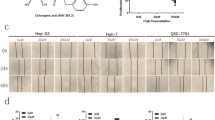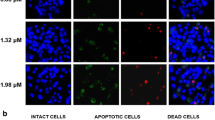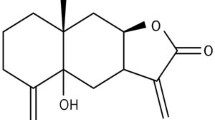Abstract
Our previous study indicated that vanadium compounds can block cell cycle progression at the G1/S phase in human hepatoma HepG2 cells via a highly activated extracellular signal-regulated protein kinase (ERK) signal. To explore their differential action on normal cells, we investigated the response of an immortalized hepatic cell line, L02 cells. The results demonstrated that a higher concentration of vanadium compounds was needed to inhibit L02 proliferation, which was associated with S and G2/M cell cycle arrest. In addition, in contrast to insignificant reactive oxygen species (ROS) generation in HepG2 cells, all of the vanadium compounds resulted significant increases in both O ·−2 and H2O2 levels in L02 cells. At the same time, ERK and c-Jun N-terminal kinase (JNK) as well as cell division control protein 2 homolog (Cdc2) were found to be highly phosphorylated, which could be counteracted with the antioxidant N-acetylcysteine (NAC). The current study also demonstrated that both the ERK and the JNK pathways contributed to the cell cycle arrest induced by vanadium compounds in L02 cells. More importantly, it was found that although NAC can ameliorate the cytotoxicity of vanadium compounds in L02 cells, it did not decrease their cytotoxicity in HepG2 cells. It thus shed light on the potential therapeutic applications of vanadium compounds with antioxidants as synergistic agents to reduce their toxicities in human normal cells without affecting their antitumor activities in cancer cells.







Similar content being viewed by others
Abbreviations
- Akt/PKB:
-
Protein kinase B
- Cdc2/Cdk1:
-
Cell division control protein 2 homolog/cyclin dependent kinase 1
- CM-H2DCF-DA:
-
5-(and-6)-Chloromethyl-2′,7′-dichlorodihydrofluorescein diacetate
- ERK:
-
Extracellular signal-regulated protein kinase
- FBS:
-
Fetal bovine serum
- HE:
-
Dihydroethidium
- JNK:
-
c-Jun N-terminal kinase
- MAPK:
-
Mitogen-activated protein kinase
- MTT:
-
3-(4,5-Dimethylthiazolyl-2)-2,5-diphenyltetrazolium bromide
- NAC:
-
N-acetylcysteine
- NaVO3 :
-
Sodium metavanadate
- PI3-K:
-
Phosphatidylinositol 3-kinase
- pRb:
-
Retinoblastoma tumor suppressor protein
- ROS:
-
Reactive oxygen species
- VO(acac)2 :
-
Bis(acetylacetonato)-oxovanadium(IV)
- VO(ma)2 :
-
Bis(maltolato)-oxovanadium(IV)
References
Evangelou AM (2002) Crit Rev Oncol Hematol 42:249–265
Ress NB, Chou BJ, Renne RA, Dill JA, Miller RA, Roycroft JH, Hailey JR, Haseman JK, Bucher JR (2003) Toxicol Sci 74:287–296
Hwang JT, Lee M, Jung SN, Lee HJ, Kang I, Kim SS, Ha J (2004) Carcinogenesis 25:2497–2507
Tang H, Sun Y, Xiu Q, Lu H, Han H (2007) Arch Biochem Biophys 468:92–99
Zhang Z, Gao N, He H, Huang C, Luo J, Shi X (2004) Mol Cell Biochem 255:227–237
Chien PS, Mak OT, Huang HJ (2006) Biochem Biophys Res Commun 339:562–568
Goc A (2006) Cent Eur J Biol 1:314–332
Desoize B (2004) Anticancer Res 24:1529–1544
Molinuevo MS, Barrio DA, Cortizo AM, Etcheverry SB (2004) Cancer Chemother Pharm 53:163–172
Gao N, Ding M, Zheng JZ, Zhang Z, Leonard SS, Liu KJ, Shi X, Jiang BH (2002) J Biol Chem 277:31963–31971
Zhang Z, Leonard SS, Huang C, Vallyathan V, Castranova V, Shi X (2003) Free Radic Biol Med 34:1333–1342
Zhang Z, Huang C, Li J, Leonard SS, Lanciotti R, Butterworth L, Shi X (2001) Arch Biochem Biophys 392:311–320
Li M, Ding W, Baruah B, Crans DC, Wang R (2008) J Inorg Biochem 102:1846–1853
Figiel I, Kaczmarek L (1997) Neuroreport 8:2465–2470
Chin LS, Murray SF, Harter DH, Doherty PF, Singh SK (1999) J Biomed Sci 6:213–218
Gamero AM, Larner AC (2001) J Biol Chem 276:13547–13553
Tracey AS, Willsky GR, Takeuchi E (2007) Vanadium: chemistry, biochemistry, pharmacology and practical applications. CRC, Boca Raton
Trachootham D, Alexandre J, Huang P (2009) Nat Rev Drug Discov 8:579–591
Thompson KH, Orvig C (2000) J Chem Soc Dalton Trans 2885–2892
Yuen VG, Caravan P, Gelmini L, Glover N, McNeill JH, Setyawati IA, Zhou Y, Orvig C (1997) J Inorg Biochem 68:109–116
Crans DC (2000) J Inorg Biochem 80:123–131
Fu Y, Wang Q, Yang XG, Yang XD, Wang K (2008) J Biol Inorg Chem 13:1001–1009
Natarajan M, Mohan S, Martinez BR, Meltz ML, Herman TS (2000) Cancer Detect Prev 24:405–414
Funk D, Schrenk H-H, Frei E (2007) Biotechniques 43:178–182
Sherr CJ (1996) Science 274:1672–1677
Reed SI (1997) Cancer Surv 29:7–23
Morgan DO (1995) Nature 374:131–134
Dunphy WG (1994) Trends Cell Biol 4:202–207
Garcia Z, Kumar A, Marques M, Cortes I, Carrera AC (2006) EMBO J 25:655–661
Meloche S, Pouyssegur J (2007) Oncogene 26:3227–3239
Chambard JC, Lefloch R, Pouyssegur J, Lenormand P (2007) Biochim Biophys Acta 1773:1299–1310
Jaspers I, Samet JM, Erzurum S, Reed W (2000) Am J Respir Cell Mol Biol 23:95–102
Toyokuni S, Okamoto K, Yodoi J, Hiai H (1995) FEBS Lett 358:1–3
Szatrowski TP, Nathan CF (1991) Cancer Res 51:794–798
Tamrakar S, Rubin E, Ludlow JW (2000) Front Biosci 5:D121–D137
Lou YW, Chen YY, Hsu SF, Chen RK, Lee CL, Khoo KH, Tonks NK, Meng TC (2008) FEBS J 275:69–88
Baran Enrique J (2003) J Braz Chem Soc 14:878–888
Legrum W (1986) Toxicology 42:281–289
Crans DC, Zhang B, Gaidamauskas E, Keramidas AD, Willsky GR, Roberts CR (2010) Inorg Chem. doi:10.1021/ic100080k
Wang YF, Jiang CC, Kiejda KA, Gillespie S, Zhang XD, Hersey P (2007) Clin Cancer Res 13:4934–4942
Javvadi P, Segan AT, Tuttle SW, Koumenis C (2008) Mol Pharmacol 73:1491–1501
Wang J, Yi J (2008) Cancer Biol Ther 7:1875–1884
Yang XG, Yang XD, Yuan L, Wang K, Crans DC (2004) Pharm Res 21:1026–1033
Capella MA, Capella LS, Valente RC, Gefe M, Lopes AG (2007) Cell Biol Toxicol 23:413–420
Montalto G, Cervello M, Giannitrapani L, Dantona F, Terranova A, Castagnetta LA (2002) Ann N Y Acad Sci 963:13–20
Sangiovanni A, Del Ninno E, Fasani P, De Fazio C, Ronchi G, Romeo R, Morabito A, De Franchis R, Colombo M (2004) Gastroenterology 126:1005–1014
Villanueva A, Chiang DY, Newell P, Peix J, Thung S, Alsinet C, Tovar V, Roayaie S, Minguez B, Sole M, Battiston C, Van Laarhoven S, Fiel MI, Di Feo A, Hoshida Y, Yea S, Toffanin S, Ramos A, Martignetti JA, Mazzaferro V, Bruix J, Waxman S, Schwartz M, Meyerson M, Friedman SL, Llovet JM (2008) Gastroenterology 135:1972–1983
Davila JA, Morgan RO, Shaib Y, McGlynn KA, El-Serag HB (2005) Gut 54:533–539
Dann SG, Selvaraj A, Thomas G (2007) Trends Mol Med 13:252–259
Thompson KH, Orvig C (2006) J Inorg Biochem 100:1925–1935
Thompson KH, Lichter J, LeBel C, Scaife MC, McNeill JH, Orvig C (2009) J Inorg Biochem 103:554–558
Sakurai H, Yoshikawa Y, Yasui H (2008) Chem Soc Rev 37:2383–2392
Faneca H, Figueiredo VA, Tomaz I, Goncalves G, Avecilla F, Pedroso de Lima MC, Geraldes CF, Pessoa JC, Castro MM (2009) J Inorg Biochem 103(4):601–608
Etcheverry SB, Ferrer EG, Naso L, Rivadeneira J, Salinas V, Williams PA (2008) J Biol Inorg Chem 13:435–447
Evans JL, Goldfine ID, Maddux BA, Grodsky GM (2002) Endocr Rev 23:599–622
Houstis N, Rosen ED, Lander ES (2006) Nature 440:944–948
Oster MH, Llobet JM, Domingo JL, German JB, Keen CL (1993) Toxicology 83:115–130
Acknowledgments
This work was supported by the National Natural Science Foundation of China (20871008) and the Scientific Research Foundation for Returned Overseas Chinese Scholars, State Education Ministry.
Author information
Authors and Affiliations
Corresponding author
Rights and permissions
About this article
Cite this article
Wang, Q., Liu, TT., Fu, Y. et al. Vanadium compounds discriminate hepatoma and normal hepatic cells by differential regulation of reactive oxygen species. J Biol Inorg Chem 15, 1087–1097 (2010). https://doi.org/10.1007/s00775-010-0668-4
Received:
Accepted:
Published:
Issue Date:
DOI: https://doi.org/10.1007/s00775-010-0668-4




